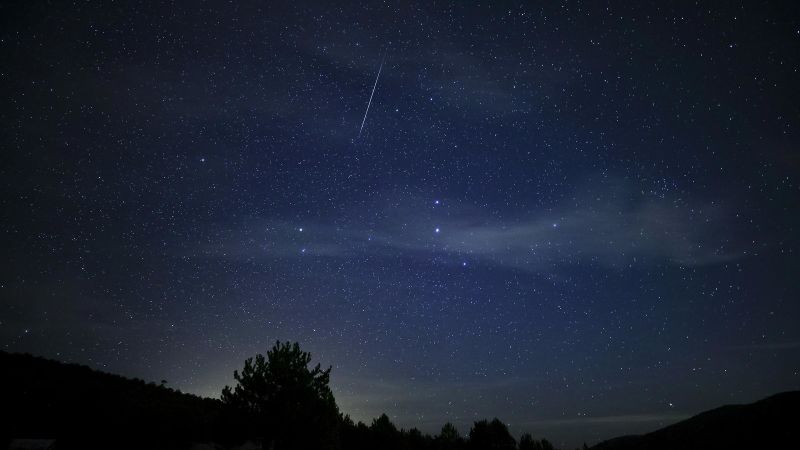As the new year begins, one of the most exhilarating spectacles of the night sky, the Quadrantid meteor shower, reaches its peak. This meteor shower, renowned for being one of the strongest of the year, promises a stunning display for stargazers. According to NASA, the Quadrantids have a unique characteristic—their peak only lasts about six hours, making them not only spectacular but also fleeting compared to other meteor showers that can span multiple nights. Therefore, for those keen on witnessing this astronomical event, it’s essential to be vigilant and prepared during the limited time of its peak.
Meteors, the highlights of such meteor showers, consist of debris left behind by broken asteroids or particles from comets. Each year, as Earth travels through these dusty trails—fragments orbiting the sun—the particles create brilliant, fiery displays upon entering our planet’s atmosphere. As these pieces of dust and rock burn up, they create colorful streaks across the sky, enchanting those lucky enough to watch.
The limited duration of the Quadrantids’ peak is due to the unique nature of its particle trail. NASA explains that the meteor shower features a relatively thin stream of particles, and Earth passes through it quickly, intersecting with the densest part of these particles at a perpendicular angle. This factor necessitates timely observation, with maximum meteor activity anticipated between 10 a.m. and 1 p.m. ET, on January 3. Regions such as Alaska, Hawaii, and parts of far eastern Asia may experience the most optimal viewing conditions during this peak time, as noted by Bob Lunsford, the fireball report coordinator for the American Meteor Society.
As dawn approaches, the best time to catch a glimpse of the meteors is in the pre-dawn hours. Skywatchers on the east coast of North America may expect to see about 25 meteors per hour, while those on the west coast might see an even greater number—potentially doubling that amount—thanks to a later sunrise. In western Alaska, if conditions remain clear, observers could witness over 100 meteors per hour, creating a breathtaking nighttime show.
The viewing conditions are further enhanced by the presence of a waxing crescent moon, which will set well before midnight—providing unobstructed visibility for the meteor shower. Although the Quadrantids do not typically exhibit long, persistent trails, they are capable of producing impressive fireballs—intense bursts of light and color associated with larger particles that create longer-lasting displays.
Interestingly, the Quadrantids are mostly invisible from the Southern Hemisphere because their radiant point—the origin of the meteors—remains comparatively low on the horizon before dawn. For those in urban areas plagued by light pollution, it is advisable to venture into darker regions for improved visibility. Finding an open area with a clear view of the sky while allowing your eyes time to adjust to the darkness is crucial for maximizing your experience.
The name “Quadrantids” may appear unusual as it doesn’t directly correlate to a current constellation. This is because the Quadrantids are named after an obsolete constellation known as Quadrans Muralis, which was first observed in 1795. This constellation has since fallen out of use, according to EarthSky, and is absent from the modern list of recognized celestial formations.
The radiant point of the Quadrantids lies at the right angle between the Big Dipper and Arcturus. However, meteors can appear anywhere in the sky, so observers should remain flexible in their viewing direction. Unlike some meteor showers, which originate from icy comets, the Quadrantids stem from a “rock comet,” specifically the asteroid designated as 2003 EH1, which possesses an orbital period of about 5.52 years.
Additionally, it is suggested that comet 96P/Machholz might also contribute to the Quadrantid meteor shower. Scientists theorize this comet, which orbits the sun every 5.3 years, coupled with a larger comet that became gravitationally bound to a short orbit around 2000 BC, is responsible for leaving behind a complex of meteors—particularly those belonging to the Machholz Complex, which also comprises two other comet groups and several meteor showers.
As the Quadrantids wrap up their display, the next significant meteor showers will come in April, including the Lyrids and Eta Aquariids. The calendar of remaining meteor showers for 2025 showcases various celestial events, inviting skywatchers to continue their exploration of the night sky throughout the year.
Thus, while the Quadrantids may only make their appearance for a fleeting moment, they offer a promising glimpse into the wonders of our universe, illustrating the remarkable phenomena found beyond our atmosphere.



